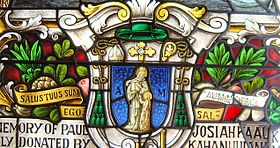Roman Catholic Diocese of Honolulu
The patron saint of the Diocese of Honolulu is the Blessed Virgin Mary, under the title of Malia O Ka Malu or Our Lady Queen of Peace.
The diocese ministers to Hawaiian, English, Ilokano, Tagalog, Samoan, Tongan, Japanese, Korean, Spanish, and Vietnamese congregants.
[6] However, the priests received support from the high chief Boki, the royal governor of Oahu, and his wife Kuini Liliha.
Commodore John Downes of the United States Navy USS Potomac intervened on the converts' behalf with Kamehameha III, stopping the mistreatment.
[8][7] In 1835, Vicar Apostolic Étienne Rouchouze and Bachelot dispatched Columba Murphy, a Picpus religious brother, to Hawaii to evaluate the situation.
Kamehameha III initially refused Walsh's entry, but a French naval officer persuaded the king to let him stay.
Kamehameha III also agreed to permit the Picpus Fathers to work freely in Hawaii so long as they only ministered to foreigners.
[8][7] Captain Cyrille Laplace had been ordered by his government to:''...to make it well understood that it would be to the advantage of the chiefs of those islands of the Ocean to conduct themselves in such a manner as not to incur the wrath of France.
''Fearing a French assault, Kamehameha III issued the Edict of Toleration in July 1839, granting religious freedom to all Catholics in Hawaii.
[9] Shortly after the Edict of Toleration was issued, Rouchouze arrived in Honolulu with three Picpus priests, including the previously exiled Louis Maigret.
For the rest of 1840, devotees harvested large blocks of coral off the Oahu coastline to build the future Cathedral Basilica of Our Lady of Peace.
St. Raphael's Parish was established on the Island of Kauai in 1841, the first Catholic church there[11] In January 1842, Rouchouze set sail to France to recruit more Picpus priests and brothers to serve in Hawaii.
[18] One year later, a group of American businessmen, aided by a contingent of United States Marines, overthrew Queen Liliʻuokalani and established a Republic of Hawaii.
Ropert died in 1903.The next vicar apostolic of the Hawaiian Islands was Monsignor Libert Boeynaems, appointed by Leo XIII in 1903.
[20] With the establishment of Naval Station Pearl Harbor in 1900, Fort Shafter in 1907, and Schofield Barracks in 1908 Boeynaems started ministering to many Catholics in the US Armed Forces.
He also oversaw the renovation of the Cathedral Basilica of Our Lady of Peace, modernizing it in time for the centennial celebration of the Catholic Church in Hawaii in 1927.
[22] Motivated by the reforms of the Second Vatican Council in the early 1960s, Sweeney renovated the Cathedral Basilica of Our Lady of Peace in keeping with the newly promulgated Constitution on the Sacred Liturgy.
Soon all the parishes offered Mass primarily in the vernacular in place of Latin and altars were built facing the congregation instead of the sanctuary wall.
[23] Scanlan invited the Society of Jesus, the Christian Brothers of Ireland, the Religious of the Virgin Mary, and the Dominican Sisters of Iloilo to enter the diocese.
[25] Ferrario revamped major diocesan offices and appointed pastors to parishes that were supportive of his vision of implementing the Second Vatican Council.
[27] Monsignor Clarence Silva of San Francisco became the first native-born bishop of Honolulu, named by Pope Benedict XVI in 2005.
In 1989, David Figueroa anonymously accused Bishop Ferrario of sexually abusing him when he was a young child in Kailua.
[35] In April 2020, Bishop Silva announced during a Sunday mass that the diocese was paying millions to settle prior sex abuse cases.









